With savory and juicy sliced beef served over steamed rice, this delicious Yoshinoya Beef Bowl (Gyudon) is a keeper for a weeknight meal!
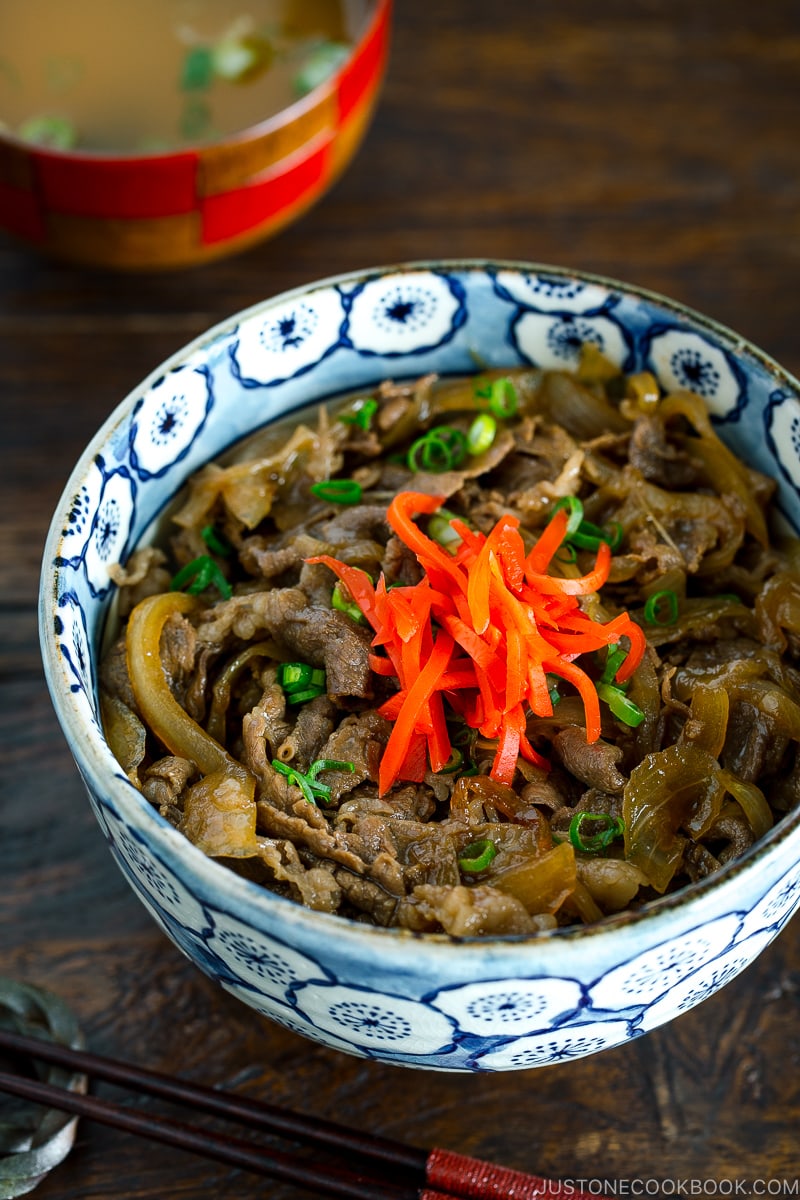
Gyudon (牛丼) or Beef Bowl is a popular quick meal in Japan. It consists of a bowl of steamed rice topped with thinly sliced beef and tender onion, simmered in a sweet and savory dashi broth seasoned with soy sauce and mirin.
What is Beef Bowl (Gyudon)?
Thanks to Yoshinoya (吉野家), the largest beef bowl restaurant chain, Japanese gyudon became known as the “beef bowl” and is enjoyed by many people all around the world. You might wonder when the Japanese started to enjoy gyudon.
The Japanese adopted Western customs like eating beef between the late 1800s and early 1900s and these customs eventually spread throughout Japan.
Gyudon originated from another dish, Gyunabe (牛鍋) and Sukiyaki (すき焼き) where thin slices of beef are cooked with vegetables in a pot. At some point, it was served over rice in a bowl as “donburi” (rice bowl).
In 1899, the first Yoshinoya restaurant opened in Tokyo’s Nihonbashi district. The use of cheaper beef cuts helped lower the cost, and ultimately drove the success of Gyudon. Today, it continues to be a popular quick, and inexpensive lunch menu for salarymen.
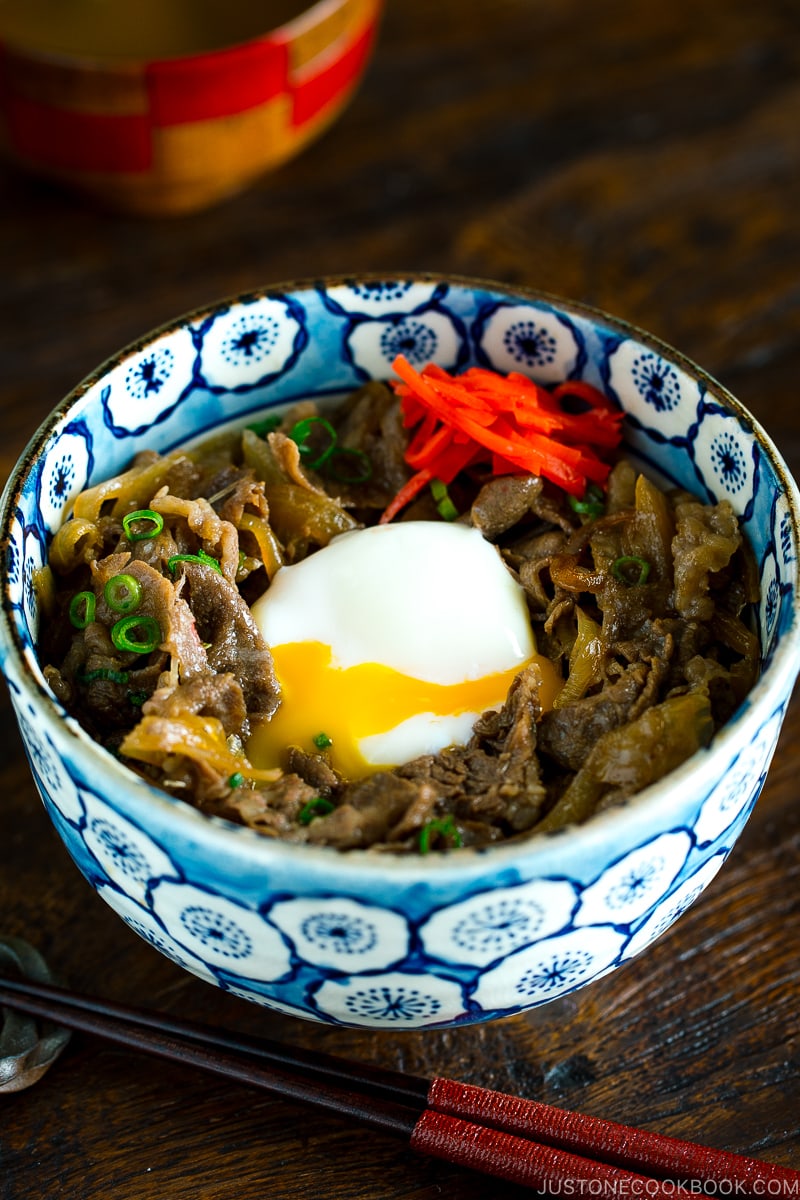
How to Make Yoshinoya Beef Bowl
In Yoshinoya’s gyudon, they simmer onion and thinly sliced beef in dashi broth and other seasonings. Every household makes gyudon slightly different, so feel free to adjust the flavor as you like.
Ingredients You’ll Need
- Thinly Sliced Beef: If you don’t eat beef, you can make this dish with thinly sliced pork as well. Just make sure the meat is thinly sliced. Japanese, Korean, and Chinese grocery stores carry thinly sliced meat (both pork and beef), but if you can’t find it in the refrigerated or frozen meat sections, you can purchase a block of meat and slice them on your own. I’ve added the instructions in the recipe below.
- Onion: If you really do not like onion, you can skip it; otherwise, please include it. Cooked onions are tender and give sweetness to the sauce. I consider the onion just as important as the meat in this recipe. You can use regular yellow onion, sweet onion, or even purple onion (if the color doesn’t bother you).
- Shirataki Noodles (Optional): I usually cook gyudon at the very last minute (not planned) so I don’t have shirataki noodles in my fridge. However, it’s a great addition to gyudon and it’s a smart way to add the volume of the food without adding more meat. The texture also improves with shirataki noodles.
- Dashi: This recipe requires dashi. We cook the beef and onion in the dashi-based sauce. You can make dashi in 3 ways if you’re not sure how to make it.
- Seasonings: This recipe requires basic Japanese condiments—sake, mirin, soy sauce, and sugar.
- Steamed rice: You will need a little bit more amount of steamed rice than the usual rice bowl amount.
- Pickled Red Ginger (beni shoga): Typically, pickled red ginger is served on top of gyudon, and it gives a nice refreshing break to your palate. Similar to how sliced pickles are added inside juicy burgers. I personally like every bite to include a bit of pickled ginger but the amount is entirely up to you.
- Shichimi Togarashi (Japanese seven spice): If you like it spicy or got bored eating the same gyudon, sprinkle some shichimi togarashi on top. It’s a mixture of seven different kinds of spices and adds layers of flavors.
Overview: Cooking Steps
- Prepare the ingredients by cutting the onion, green onion, and beef. Make dashi if you haven’t already.
- Cook the onion till tender in the dashi and seasonings mixture.
- Add the beef and simmer with the onion.
- Serve the gyudon over steamed rice.
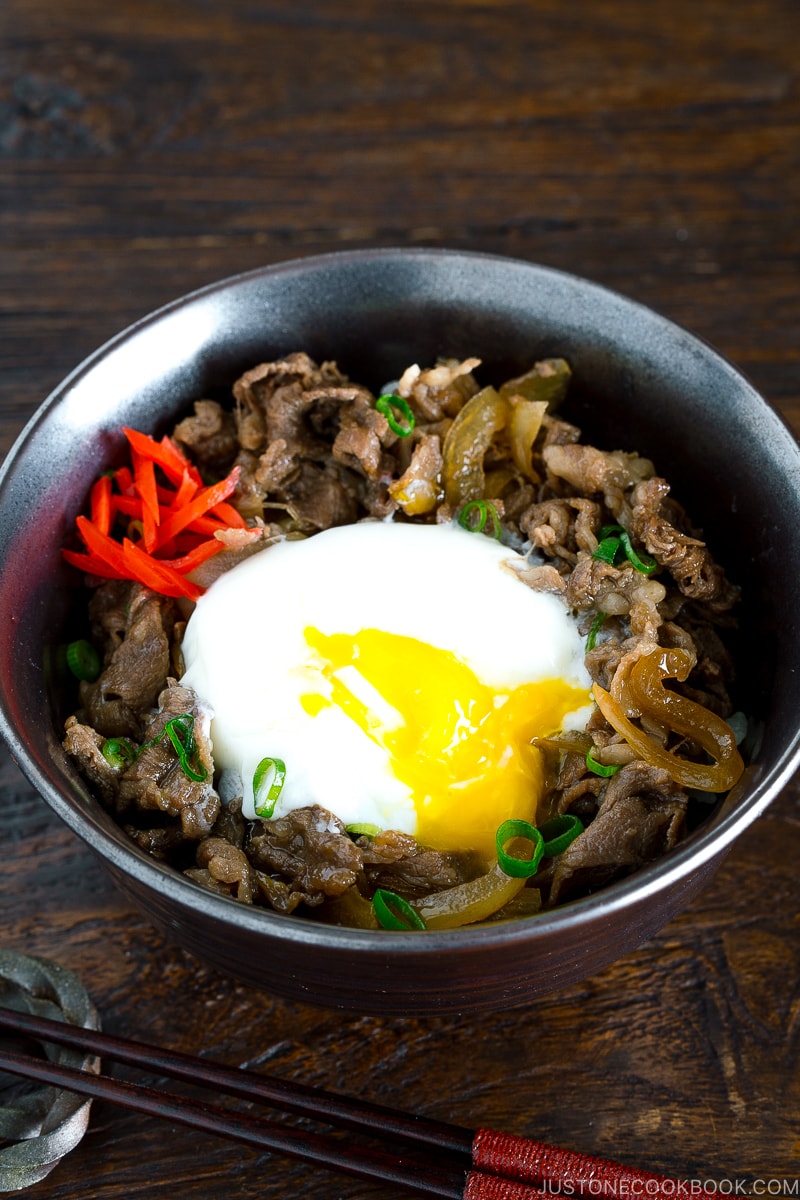
What to Serve with Yoshinoya Beef Bowl
We almost always serve donburi or rice bowl dish with miso soup. As you’re required to make dashi for this gyudon recipe, you might want to make a big pot of dashi. Take out some of the dashi for gyudon and keep the rest for miso soup.
Delicious Side Dishes
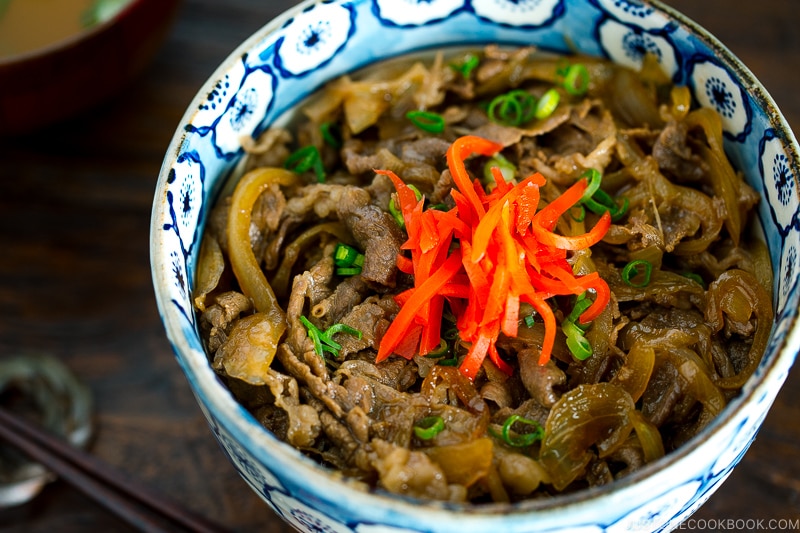
Wish to learn more about Japanese cooking? Sign up for our free newsletter to receive cooking tips & recipe updates! And stay in touch with me on Facebook, Pinterest, YouTube, and Instagram.
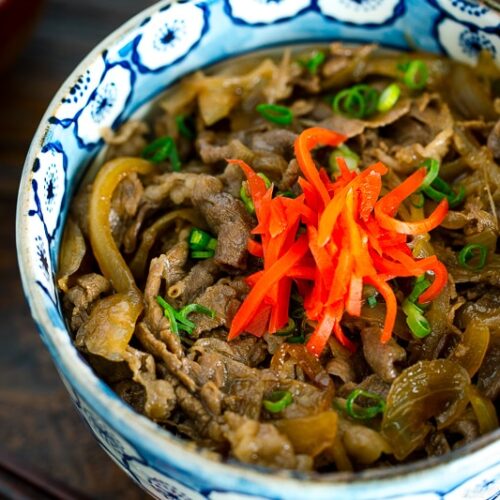
Yoshinoya Beef Bowl (Gyudon)
Video
Ingredients
- ½ onion (3 oz, 85 g)
- 1 green onion/scallion
- ½ cup dashi (Japanese soup stock) (use standard Awase Dashi, dashi packet or powder, or Vegan Dashi)
- 1 Tbsp sake
- 2 Tbsp mirin
- 1 Tbsp sugar (or more, to taste)
- 2 Tbsp soy sauce
- ¾ lb thinly sliced beef (chuck or ribeye) (12 oz, 340 g; I use komagire beef from the Japanese market; use shabu shabu beef for higher quality; or slice your own meat)
- 2 Tbsp pickled red ginger (beni shoga or kizami beni shoga)
For Serving
- 2 servings cooked Japanese short-grain rice (typically 1⅔ cups (250 g) per donburi serving)
- 2 onsen tamago (optional)
Instructions
Before You Start…
- Gather all the ingredients. For the steamed rice, please note that 1½ cups (300 g, 2 rice cooker cups) of uncooked Japanese short-grain rice yield 4⅓ cups (660 g) of cooked rice, enough for 2 donburi servings (3⅓ cups, 500 g). See how to cook short-grain rice in a rice cooker, pot over the stove, Instant Pot, or donabe.

- For the beef, I use assorted thin sliced beef labeled “komagire“ from my Japanese market and cut the slices further into smaller pieces. It works great for Gyudon. For higher quality, use shabu shabu beef. If you cannot find thin sliced beef in your local grocery store, you can slice your own meat. Freeze a block of fresh chuck or rib eye beef for 1–2 hours and then slice. If the pieces are too large after slicing, then cut them in half. See my tutorial for detailed instructions.

To Prepare the Ingredients
- Cut ½ onion into thin slices and slice 1 green onion/scallion into thin rounds. Set aside.

- Heat a large frying pan over medium-high heat and add ½ cup dashi (Japanese soup stock), 1 Tbsp sake, 1 Tbsp sugar, 2 Tbsp mirin, and 2 Tbsp soy sauce. Tip: Add more sugar, if you prefer a sweeter taste. I don‘t recommend reducing the amount, as you need to counterbalance the salt in the soy sauce.

- Cover the pan with a lid and bring the sauce to a boil. Once the sauce is boiling, add the sliced onions and spread them out in a single layer. Cover to cook until tender (make sure you cover the pan, otherwise the sauce will evaporate).

- When the onions are tender, add ¾ lb thinly sliced beef (chuck or ribeye) and cook until it‘s no longer pink. Remove the foam and fat with a fine-mesh skimmer.

To Serve
- Divide 2 servings cooked Japanese short-grain rice into individual serving bowls. Serve the simmered meat and sauce over the steamed rice.

- Top with the sliced green onions and 2 Tbsp pickled red ginger (beni shoga or kizami beni shoga). If you‘d like to top each bowl with an egg (optional), serve with 2 onsen tamago. Alternatively, you can pour beaten egg over the meat when it’s almost finished cooking in the pan (see how I do it in my other Gyudon recipe).

To Store
- You can keep the leftovers in an airtight container and store in the refrigerator for up to 3–4 days or in the freezer for a month.
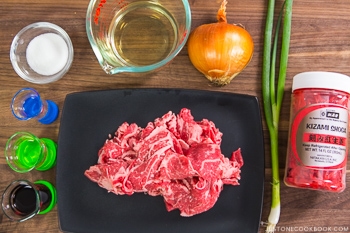
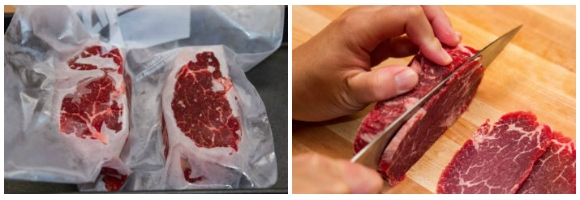
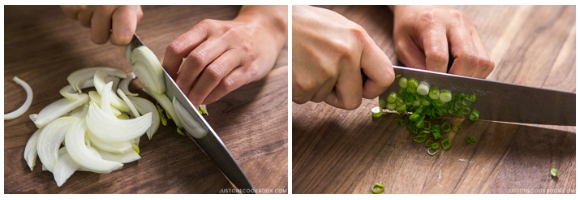
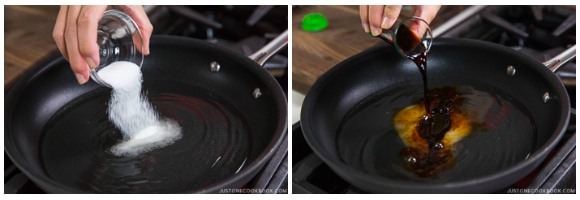
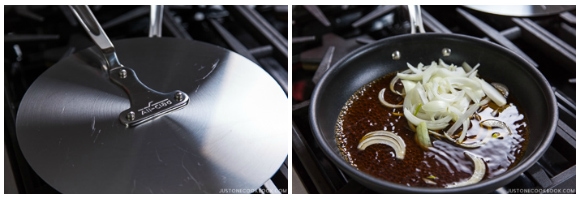
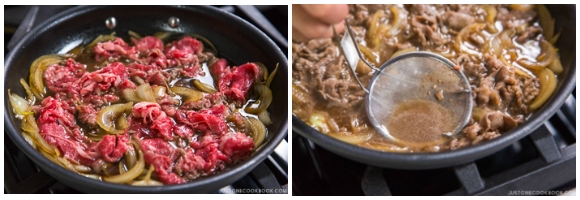
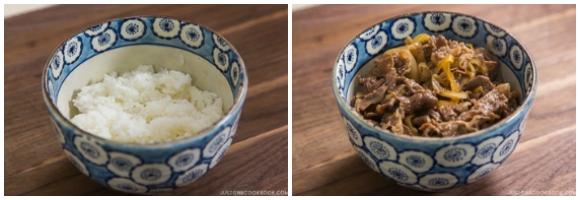
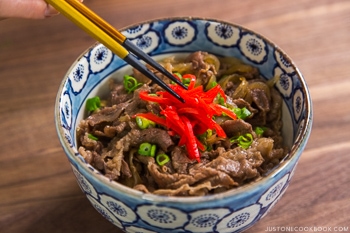

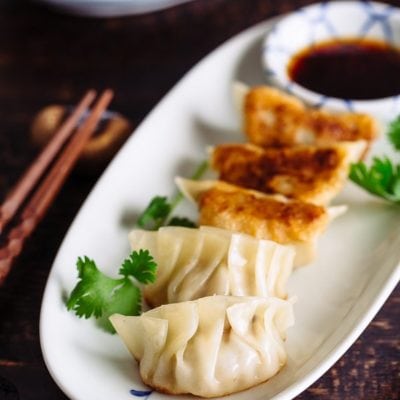



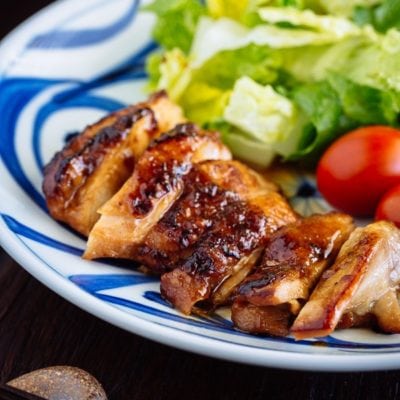
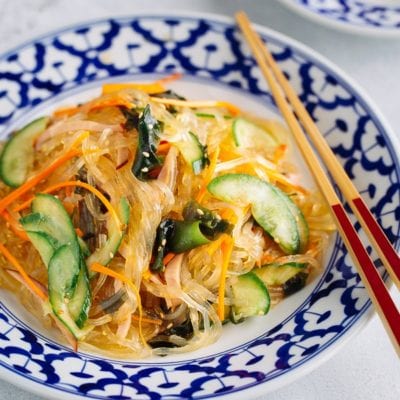
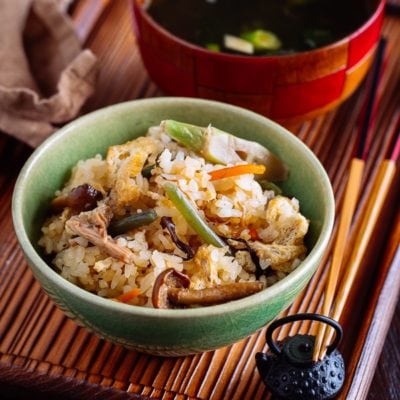
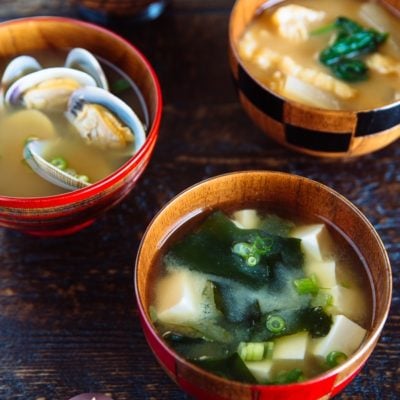
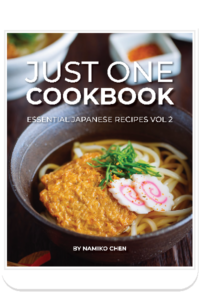
Hi Namiko!
Have you recently modified your recipe?
We haven’t made it in about a year, but this time it seemed to have less flavor than usual.
We don’t think we missed any ingredients!
Thanks!
Hi Eric! Thank you for trying Nami’s recipes!
We have not made any changes to this recipe. However, Nami has another Gyudon recipe. This could be the recipe you tried previously…. 🤔
https://www.justonecookbook.com/gyudon/
It turnes out really tasty ! Not exactly like yoshinoya, but close enough ! Although, it did produce A LOT of soupysauce. I used high quality fondue meat, but it came out a bit tough. I will try fattier meat next time. Thank you 🙂
Hi Arkel! Thank you for trying Nami’s recipe and for your feedback!😊
We are so happy to hear you enjoyed the recipe. Happy Cooking!
Excellent recipe, delicious, authentic and so easy.
Hi Iris! We are so happy to hear you enjoyed the homemade Yoshinoya Beef Bowl!
Thank you for trying Nami’s recipe and for your kind feedback!
How do you know the calories in this and is that including rice? Also calories for one serving?
thank you
Hi David! Thank you very much for reading Nami’s post!
The nutrition information is for one serving and includes rice, but not Onsen Tamago (Optional).
We hope this helps!
Love this recipe! Super quick and easy. I buy the thin beef for shabu and it’s perfect.
Hi Jeanette! Thank you very much for trying Nami’s recipe and for your kind feedback!
We are so happy to hear you enjoyed this recipe!😊
I don’t eat fish so it made eating in Japan a challenge. I found Yoshinoya and loved Japanese fast food. This brought back memories and rave reviews from my family.
Hi Rachel! Thank you very much for reading Nami’s post!
We are glad to hear you enjoyed the Yoshinoya beef bowl in Japan. We hope this recipe helps you to enjoy the same favorite at your home.
Happy Cooking!
Hi Namiko, I love all these recipes here but can I substitute Mirin and Sake with something else as we cannot consume alcohol?
Hi Carol! Thank you very much for reading Namiko’s post and trying her recipe! 🙂
Yes. You can substitute Mirin with “Honteri Mirin” by Mizkan, which contains no alcohol. Or use water and sugar. The ratio of water and sugar should be 3 to 1.
As for Sake, you can omit Sake or replace it with water or broth when a recipe calls for Sake for steaming or making a sauce.
https://www.justonecookbook.com/mirin/
https://www.justonecookbook.com/sake/
We hope this helps!
It didn’t taste right the first time, but turns out I just like mine sweeter. Added some more sugar and it was perfect. Thank you so much for the recipe!!
Hi Amy! Thank you very much for trying Nami’s recipe and for your feedback!
We are glad to hear you were able to adjust and enjoyed Gyudon!
Sounds delicious! What would be a good vegetable side dish to serve with this, do you think?
What dashi combination is good for this dish?
Hi Joyce, We recommend using Awase Dashi for this recipe.
Nami usually uses Awase Dashi for Japanese dishes unless otherwise mentioned in her recipe.🙂
We hope this helps! Thank you for trying this recipe.
This was my first attempt at any rice bowl dish at home
I have missed japanese cooking for years since my last assignment there, so I was very eager to try. The instructions for this is clear and consise and easy to follow. The dish tastes very good, so much so that guests who for their own reasons never have seconds had thirds even.
Enjoy!
Hi Halgeir! We are glad you and your guests enjoy the beef bowl.
We are so happy to hear Nami’s instructions were clear and easy to follow!
Thank you very much for trying this dish and for your kind feedback.
Hello, I have a question: Can you use wagyu beef for this too?
Hi Jayden! Sure! It will be a delicious wagyu beef bowl. Enjoy!
Easy peasy yet flavours are superb! My kids love this, reminds us of our trip to Japan 🥰 Thanks heaps for sharing the recipe and tips…blessings 💕
Hi Anna! We are so happy to hear this recipe turned out great and reminds you of your trip to Japan!
Thank you for trying this recipe and for your kind feedback.
I made this Yoshinoya Beef bowl recipe as the main dish on a bento. I paired it with Kimpira Gobo (your recipe), boiled Komatsuna and daikon and carrot salad (your recipe). For dessert, I made candied sweet potatoes with black sesame seeds (your recipe).
This is the first time I am leaving a comment but I have made dozens of your recipes already including Osechi Ryori for New Year.
Thank you for sharing your recipes and tips with us.
Hi Liza! Aww… Thank you very much for trying many of Nami’s recipes, including the Osechi Ryori for the New Year! Yay! We are so happy to hear you enjoyed many of them and your meal plan is wonderful! Happy Cooking!
Thank you, Nami-san, for this recipe. My son in law said this is the best beef he’s had! He said there’s so much depth to the flavor.
Quick and easy recipe is an added bonus for me.
Thank you! Love your recipes!
Hi Karen, Yay! Thank you very much for trying this recipe and for your kind feedback!